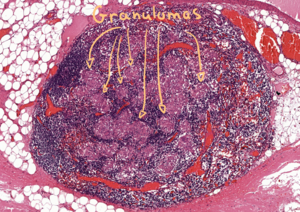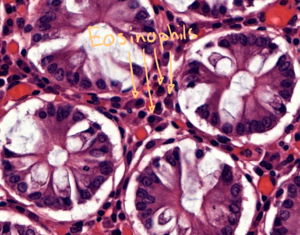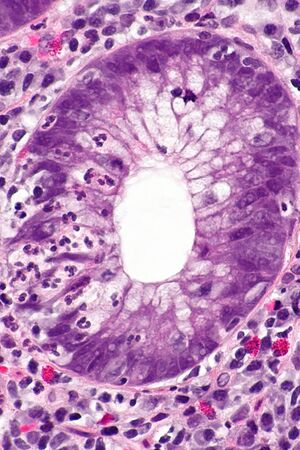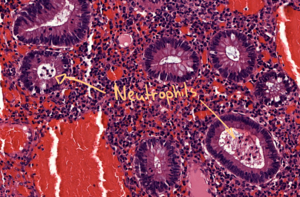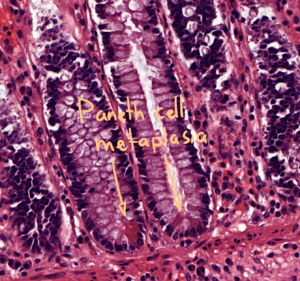4. Crohn’s disease: Difference between revisions
(Created page with "'''Staining''': HE '''Organ''': Large intestine '''Description''': Many histological findings are important in Crohn’s. Not all of them can be found on this slide: An aphthous ulcer, which is a knifelike deep ulcer, is present. Non-caseating granulomas are visible throughout the whole thickness of the wall. These contain giant cells. Plasma cells, lymphocytes and eosinophils are abundant throughout the whole thickness of the wall. Cryptal distortion, where the c...") |
No edit summary |
||
| Line 1: | Line 1: | ||
'''Staining''': HE | [[File:Crohn disease - overview.png|thumb|Overview. Granulomas are found throughout the thickness of the wall.|376x376px]]'''Staining''': HE | ||
'''Organ''': Large intestine | '''Organ''': Large intestine | ||
| Line 9: | Line 9: | ||
An aphthous ulcer, which is a knifelike deep ulcer, is present. | An aphthous ulcer, which is a knifelike deep ulcer, is present. | ||
Non-caseating granulomas are visible throughout the whole thickness of the wall. These contain giant cells. | Non-caseating granulomas are visible throughout the whole thickness of the wall. These contain giant cells.[[File:Crohn disease - lymphocytes.png|thumb|Lymphocytes and plasma cells infiltrate the whole thickness of the wall (the whole thickness isn’t pictured here)|325x325px]]Plasma cells, lymphocytes and eosinophils are abundant throughout the whole thickness of the wall. | ||
Plasma cells, lymphocytes and eosinophils are abundant throughout the whole thickness of the wall. | |||
Cryptal distortion, where the crypts lose their normal round shape and instead take on an irregular shape is present. | Cryptal distortion, where the crypts lose their normal round shape and instead take on an irregular shape is present. | ||
| Line 19: | Line 17: | ||
Cryptal abscess, where neutrophils are present in the lumen of the crypts, is present. | Cryptal abscess, where neutrophils are present in the lumen of the crypts, is present. | ||
Paneth cell metaplasia, where Paneth cells are not normally present (the left colon), is present. If Crohn’s affects a part of the colon where Paneth cells are normally present (the right colon), there will be Paneth cell hyperplasia. Paneth cells have large eosinophilic granules that make their cytoplasm look reddish. Look for reddish parts on the bottom of crypts. | Paneth cell metaplasia, where Paneth cells are not normally present (the left colon), is present. If Crohn’s affects a part of the colon where Paneth cells are normally present (the right colon), there will be Paneth cell hyperplasia. Paneth cells have large eosinophilic granules that make their cytoplasm look reddish. Look for reddish parts on the bottom of crypts.[[File:Crohn disease - cryptal distortion.png|thumb|Cryptal distortion|280x280px]]Pseudopyloric metaplasia, where the colonic crypts become more like pyloric glands, is probably not present on the slide. | ||
Pseudopyloric metaplasia, where the colonic crypts become more like pyloric glands, is probably not present on the slide. | |||
'''Diagnosis''': Crohn’s disease | '''Diagnosis''': Crohn’s disease | ||
| Line 35: | Line 31: | ||
The crypts are distorted because they are repeatedly destroyed and regenerated due to inflammation. | The crypts are distorted because they are repeatedly destroyed and regenerated due to inflammation. | ||
[[File:Crohn disease - | [[File:Crohn disease - granulomas.png|thumb|Granulomas|left]] | ||
[[File:Crohn disease - giant cells.png|thumb|Giant cells]] | |||
[[File:Crohn disease - eosinophils.png|thumb|Eosinophils|left]] | |||
[[File:Crohn disease - cryptitis.jpg|thumb|Neutrophils in the walls of the crypts = cryptitis. This picture is NOT from our slide, it’s from <nowiki>https://librepathology.org/wiki/Cryptitis</nowiki>. I could not find evidence of cryptitis on the slide, however our teacher said that there should be. Maybe you’ll find it.]] | |||
[[File:Crohn disease - giant cells.png | [[File:Crohn disease - cryptal abscess.png|thumb|Neutrophils in the lumen of the crypts = cryptal abscess|left]] | ||
[[File:Crohn disease - eosinophils.png | [[File:Crohn disease - Paneth cell metaplasia.png|thumb|Paneth cell metaplasia|left]] | ||
[[File:Crohn disease - cryptitis.jpg | |||
[[File:Crohn disease - cryptal abscess.png | |||
[[File:Crohn disease - Paneth cell metaplasia.png | |||
[[Category:Pathology 2 - Histopathology slides]] | [[Category:Pathology 2 - Histopathology slides]] | ||
Latest revision as of 13:14, 7 July 2024
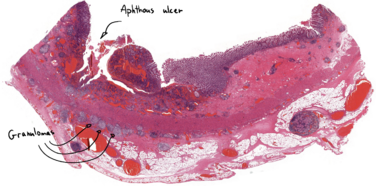
Staining: HE
Organ: Large intestine
Description:
Many histological findings are important in Crohn’s. Not all of them can be found on this slide:
An aphthous ulcer, which is a knifelike deep ulcer, is present.
Non-caseating granulomas are visible throughout the whole thickness of the wall. These contain giant cells.
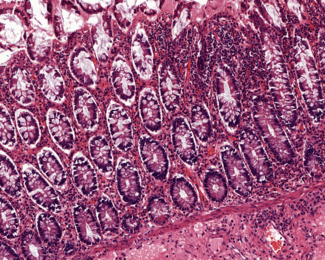
Plasma cells, lymphocytes and eosinophils are abundant throughout the whole thickness of the wall.
Cryptal distortion, where the crypts lose their normal round shape and instead take on an irregular shape is present.
Cryptitis, where neutrophils are present in the walls of the crypts, may be present.
Cryptal abscess, where neutrophils are present in the lumen of the crypts, is present.
Paneth cell metaplasia, where Paneth cells are not normally present (the left colon), is present. If Crohn’s affects a part of the colon where Paneth cells are normally present (the right colon), there will be Paneth cell hyperplasia. Paneth cells have large eosinophilic granules that make their cytoplasm look reddish. Look for reddish parts on the bottom of crypts.
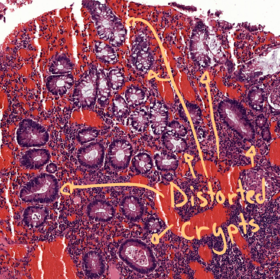
Pseudopyloric metaplasia, where the colonic crypts become more like pyloric glands, is probably not present on the slide.
Diagnosis: Crohn’s disease
Risk factors:
- Western diet
- Genetic factors
Theory:
Granulomas are only found in 40% of cases, so absence of them is not enough to exclude Crohn’s.
The crypts are distorted because they are repeatedly destroyed and regenerated due to inflammation.
